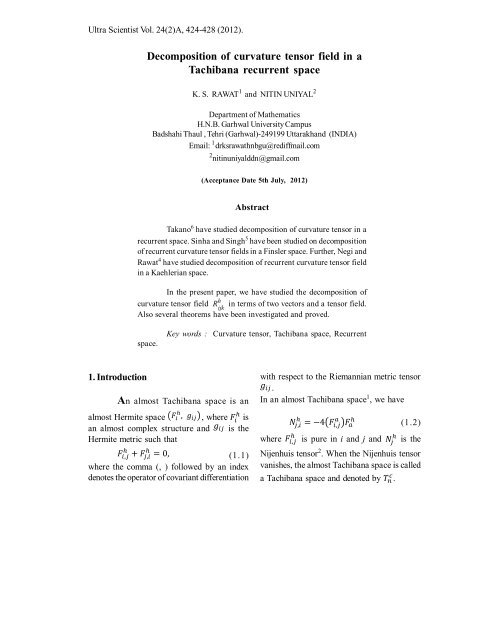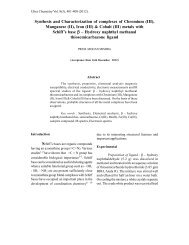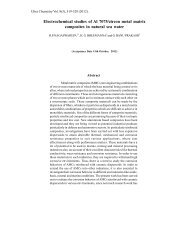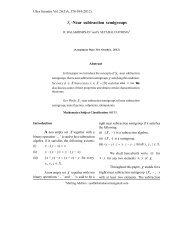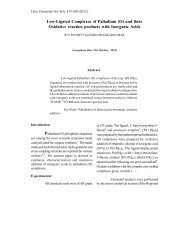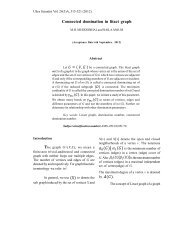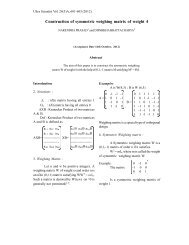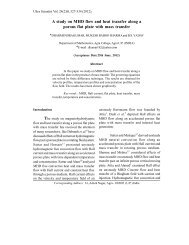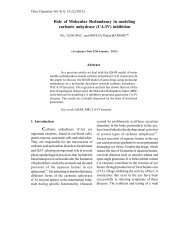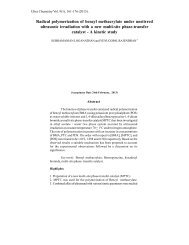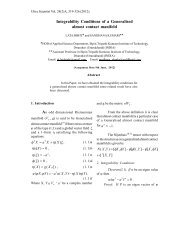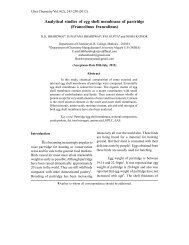Decomposition of curvature tensor field in a ... - Ultrascientist.org
Decomposition of curvature tensor field in a ... - Ultrascientist.org
Decomposition of curvature tensor field in a ... - Ultrascientist.org
Create successful ePaper yourself
Turn your PDF publications into a flip-book with our unique Google optimized e-Paper software.
Ultra Scientist Vol. 24(2)A, 424-428 (2012).<br />
<strong>Decomposition</strong> <strong>of</strong> <strong>curvature</strong> <strong>tensor</strong> <strong>field</strong> <strong>in</strong> a<br />
Tachibana recurrent space<br />
K. S. RAWAT 1 and NITIN UNIYAL 2<br />
Department <strong>of</strong> Mathematics<br />
H.N.B. Garhwal University Campus<br />
Badshahi Thaul , Tehri (Garhwal)-249199 Uttarakhand (INDIA)<br />
Email: 1 drksrawathnbgu@rediffmail.com<br />
2 nit<strong>in</strong>uniyalddn@gmail.com<br />
(Acceptance Date 5th July, 2012)<br />
Abstract<br />
Takano 6 have studied decomposition <strong>of</strong> <strong>curvature</strong> <strong>tensor</strong> <strong>in</strong> a<br />
recurrent space. S<strong>in</strong>ha and S<strong>in</strong>gh 5 have been studied on decomposition<br />
<strong>of</strong> recurrent <strong>curvature</strong> <strong>tensor</strong> <strong>field</strong>s <strong>in</strong> a F<strong>in</strong>sler space. Further, Negi and<br />
Rawat 4 have studied decomposition <strong>of</strong> recurrent <strong>curvature</strong> <strong>tensor</strong> <strong>field</strong><br />
<strong>in</strong> a Kaehlerian space.<br />
In the present paper, we have studied the decomposition <strong>of</strong><br />
<strong>curvature</strong> <strong>tensor</strong> <strong>field</strong> R h <strong>in</strong> terms <strong>of</strong> two vectors and a <strong>tensor</strong> <strong>field</strong>.<br />
ijk<br />
Also several theorems have been <strong>in</strong>vestigated and proved.<br />
space.<br />
Key words : Curvature <strong>tensor</strong>, Tachibana space, Recurrent<br />
1. Introduction<br />
An almost Tachibana space is an<br />
almost Hermite space , where is<br />
an almost complex structure and is the<br />
Hermite metric such that<br />
(1.1)<br />
where the comma (, ) followed by an <strong>in</strong>dex<br />
denotes the operator <strong>of</strong> covariant differentiation<br />
with respect to the Riemannian metric <strong>tensor</strong><br />
.<br />
In an almost Tachibana space 1 , we have<br />
(1.2)<br />
where is pure <strong>in</strong> i and j and is the<br />
Nijenhuis <strong>tensor</strong> 2 . When the Nijenhuis <strong>tensor</strong><br />
vanishes, the almost Tachibana space is called<br />
a Tachibana space and denoted by .
K. S. Rawat, et al. 425<br />
The Riemannian <strong>curvature</strong> <strong>tensor</strong> <strong>field</strong><br />
is def<strong>in</strong>ed as<br />
=<br />
, (1.3)<br />
where and denotes the<br />
real local coord<strong>in</strong>ates.<br />
The Ricci <strong>tensor</strong> and the Scalar <strong>curvature</strong> are<br />
given by<br />
and R = respectively.<br />
It is well known that these <strong>tensor</strong>s satisfies<br />
the follow<strong>in</strong>g identities<br />
and<br />
The Bianchi identities <strong>in</strong><br />
and<br />
(1.4)<br />
(1.5)<br />
, (1.6)<br />
. (1.7)<br />
are given by<br />
(1.8)<br />
(1.9)<br />
The commutative formulae for the <strong>curvature</strong><br />
<strong>tensor</strong> <strong>field</strong>s are given as follows<br />
and<br />
, (1.10)<br />
. (1.11)<br />
A Tachibana space is said to be Tachibana<br />
recurrent space 3 , if the <strong>curvature</strong> <strong>tensor</strong> <strong>field</strong><br />
satisfies the condition<br />
where<br />
, (1.12)<br />
is anon-zero vector and is known as<br />
recurrence vector <strong>field</strong>.<br />
The space is said to be Ricci-recurrent<br />
space, if it satisfies the condition<br />
, (1.13)<br />
Multiply<strong>in</strong>g the above equation (1.13) by ,<br />
we have<br />
R.<br />
(1.14)<br />
2. <strong>Decomposition</strong> <strong>of</strong> Curvature Tensor<br />
Field :<br />
We consider the decomposition <strong>of</strong><br />
<strong>curvature</strong> <strong>tensor</strong> <strong>field</strong><br />
form<br />
where two vectors<br />
are such that<br />
<strong>in</strong> the follow<strong>in</strong>g<br />
(2.1)<br />
and a <strong>tensor</strong> <strong>field</strong><br />
. (2.2)<br />
Now, we have the follow<strong>in</strong>g:<br />
Theorem (2.1): Under the decomposition<br />
(2.1), the Bianchi identities for takes the<br />
forms,<br />
and<br />
(2.3)<br />
. (2.4)<br />
Pro<strong>of</strong>. From (1.8) and (2.1), we get<br />
(2.5)<br />
Multiply<strong>in</strong>g (2.5) by h and us<strong>in</strong>g (2.2), we get<br />
the required result (2.3).<br />
Aga<strong>in</strong>, us<strong>in</strong>g (1.9), (1.12) and (2.1), we have
426 <strong>Decomposition</strong> <strong>of</strong> <strong>curvature</strong> <strong>tensor</strong> <strong>field</strong> <strong>in</strong> a tachibana recurrent space.<br />
(2.6)<br />
Multiply<strong>in</strong>g (2.6) by h and us<strong>in</strong>g (2.2), we get<br />
. (s<strong>in</strong>ce X, i 0)<br />
(2.7)<br />
This completes the pro<strong>of</strong> <strong>of</strong> the theorem.<br />
Theorem(2.2): Under the decomposition<br />
(2.1), the <strong>tensor</strong> <strong>field</strong>s and Y j,k<br />
satisfy the relation<br />
. (2.8)<br />
Pro<strong>of</strong>. With the help <strong>of</strong> (1.4), (1.12)<br />
and (1.13), we get<br />
(2.9)<br />
Multiply<strong>in</strong>g (2.1) by h and us<strong>in</strong>g relation (2.2),<br />
we have<br />
(2.10)<br />
From (2.9) and (2.10), we get the required<br />
relation (2.8).<br />
Theorem(2.3): Under the decomposition<br />
(2.1), the quantities a and p ,h behave like the<br />
recurrent vector and contravariant vector<br />
respectively. The recurrent form <strong>of</strong> these<br />
quantities are given by<br />
and<br />
, (2.11)<br />
. (2.12)<br />
= ( ) ,<br />
(2.14)<br />
Now, multiply<strong>in</strong>g (2.14) by h , we have<br />
( ) = ( )<br />
(2.15)<br />
S<strong>in</strong>ce the expression on the right hand side <strong>of</strong><br />
(2.15) is symmetric <strong>in</strong> a and h , therefore<br />
provided .<br />
(2.16)<br />
The vector <strong>field</strong> a be<strong>in</strong>g non-zero, we can<br />
choose a proportional vector m such that<br />
(2.17)<br />
Further, differentiat<strong>in</strong>g (2.2) covariantly w.r.to<br />
x m and us<strong>in</strong>g (2.17), we have<br />
Mak<strong>in</strong>g the use <strong>of</strong> equation (2.11), we have<br />
, (s<strong>in</strong>ce ) (2.18)<br />
This proves the theorem.<br />
Theorem (2.4): Under the decomposition<br />
(2.1), the <strong>curvature</strong> <strong>tensor</strong> and Holomorphically<br />
projective <strong>curvature</strong> <strong>tensor</strong> are equal if<br />
<strong>curvature</strong> <strong>tensor</strong><br />
(2.19)<br />
Pro<strong>of</strong>. The Holomorphically Projective<br />
is def<strong>in</strong>ed by<br />
Pro<strong>of</strong>. Differentiat<strong>in</strong>g (2.9) covariantly<br />
w.r.t. x m and us<strong>in</strong>g (2.1), we have<br />
(2.13)<br />
Multiply<strong>in</strong>g (2.13) by a and us<strong>in</strong>g (2.1) and<br />
(2.9), we have<br />
where<br />
which may be expressed as<br />
(2.20)<br />
(2.21)
K. S. Rawat, et al. 427<br />
where<br />
(2.22)<br />
Contract<strong>in</strong>g <strong>in</strong>dices h and k <strong>in</strong> (2.1), we have<br />
In view <strong>of</strong> (2.23), we have<br />
,<br />
(2.23)<br />
(2.24)<br />
Mak<strong>in</strong>g use <strong>of</strong> equations (2.23) and (2.24) <strong>in</strong><br />
(2.22), we obta<strong>in</strong><br />
=<br />
Pro<strong>of</strong>. Contract<strong>in</strong>g <strong>in</strong>dices h and k<br />
<strong>in</strong> (2.1), we have<br />
(2.29)<br />
Multiply<strong>in</strong>g (2.29) by g ij on both sides, we have<br />
or,<br />
(2.30)<br />
R = , (2.31)<br />
Now, multiply<strong>in</strong>g (2.31) by k and us<strong>in</strong>g (2.2),<br />
we have<br />
or, .<br />
From equation (2.21), it is clear that<br />
if ,<br />
which <strong>in</strong> view <strong>of</strong> (2.25) becomes<br />
(2.25)<br />
(2.26)<br />
Multiply<strong>in</strong>g (2.26) by m and us<strong>in</strong>g (2.2), we<br />
obta<strong>in</strong> the required condition (2.19).<br />
Theorem(2.5): Under the decomposition<br />
(2.1), the vector X ,i and the <strong>tensor</strong> <strong>field</strong> Y j,k<br />
satisfy the relation<br />
(2.27)<br />
Pro<strong>of</strong>. Differentiat<strong>in</strong>g (2.1) covariantly<br />
w.r.t. x m and us<strong>in</strong>g (1.12), (2.1) and (2.12), we<br />
get the required result (2.27).<br />
Theorem(2.6): Under the decomposition<br />
(2.1), the scalar <strong>curvature</strong> R, satisfy the<br />
relation<br />
. (2.28)<br />
which completes the pro<strong>of</strong> <strong>of</strong> the theorem.<br />
References<br />
1. Tachibana, S., On the Bochner <strong>curvature</strong><br />
<strong>tensor</strong>, Nat. Sci. Report, Ochanomizu<br />
Univ. 18(1), 15-19 (1967).<br />
2. Yano, K., Differential Geometry <strong>of</strong> Complex<br />
and almost complex spaces, Pergamon<br />
Press (1965).<br />
3. Lal, K.B. and S<strong>in</strong>gh, S.S., On Kaehlerian<br />
spaces with recurrent Bochner <strong>curvature</strong>,<br />
Acc. Naz. Dei. L<strong>in</strong>cei, Series VIII, Vol.<br />
LI (3-4), 213-220 (1971).<br />
4. Negi, D.S. and Rawat, K.S., <strong>Decomposition</strong><br />
<strong>of</strong> recurrent <strong>curvature</strong> <strong>tensor</strong> <strong>field</strong>s <strong>in</strong> a<br />
Kaehlerian space, Acta Ciencia Indica,<br />
Vol. XXI, No. 2M, 139-142 (1995).<br />
5. S<strong>in</strong>ha, B.B. and S<strong>in</strong>gh, S.P., On decomposition<br />
<strong>of</strong> recurrent <strong>curvature</strong> <strong>tensor</strong> <strong>field</strong>s<br />
<strong>in</strong> a F<strong>in</strong>sler space , Bull. Cal. Math. Soc.,<br />
62, 91-96 (1970).<br />
6. Takano, K., <strong>Decomposition</strong> <strong>of</strong> <strong>curvature</strong><br />
<strong>tensor</strong> <strong>in</strong> a recurrent space, Tensor (N.S.),<br />
Vol. 18, No. 3, 343-347 (1967).<br />
7. Rawat, K.S., The decomposition <strong>of</strong> recurrent<br />
<strong>curvature</strong> <strong>tensor</strong> <strong>field</strong>s <strong>in</strong> a Kaehlerian space,
428 Ultra Scientist Vol.24(2)A, (2012).<br />
Acta Cien. Ind., Vol. XXXI M, No. 1,<br />
135-138 (2005).<br />
8. Rawat, K.S. and Silswal, G.P., <strong>Decomposition</strong><br />
<strong>of</strong> recurrent <strong>curvature</strong> <strong>field</strong>s <strong>in</strong> a<br />
Tachibana space, Jour. PAS, Vol. 13<br />
(Ser. A), 13-17 (2007).<br />
9. Rawat, K.S. and Dobhal G., Study <strong>of</strong><br />
decomposition <strong>of</strong> recurrent <strong>tensor</strong> <strong>field</strong>s<br />
<strong>in</strong> a Kaehlerian recurrent space, Pure and<br />
Applied Mathematika Sciences, Vol.<br />
LXVIII No. 1-2 (2008).<br />
10. Rawat, K.S. and S<strong>in</strong>gh Kunwar, The<br />
study <strong>of</strong> decomposition <strong>of</strong> <strong>curvature</strong> <strong>tensor</strong><br />
<strong>field</strong>s <strong>in</strong> a Kaehlerian recurrent space <strong>of</strong><br />
first order , Jour. <strong>of</strong> the Tensor Society,<br />
Vol. 3, 11-28 (2009) : MR 2567069.<br />
11. Rawat, K.S. and Kumar Mukesh, On<br />
<strong>curvature</strong> coll<strong>in</strong>eations <strong>in</strong> a Tachibana<br />
recurrent space, Aligarh Bull. Math.,<br />
28,No. 1-2, 63-69 (2009) : MR 2769016.<br />
12. Rawat, K.S. and Prasad Virendra, On<br />
Holomorphically projectively flat parabolically<br />
Kaehlerian spaces, Rev. Bull. Cal. Math.<br />
Soc., 18(1), 21-26 (2010).<br />
13. Rawat, K.S. and Uniyal Nit<strong>in</strong>, On<br />
<strong>in</strong>f<strong>in</strong>itesimal conformal and projective<br />
transformations <strong>of</strong> K-space and Kaehlerian<br />
recurrent space, International Trans. <strong>in</strong><br />
Mathematical Science and comp. Vol.<br />
3, No. 2, 205-213 (2010).<br />
14. Rawat, K.S. and Uniyal Nit<strong>in</strong>, On Conformal<br />
transformation <strong>in</strong> an almost Kaehlerian<br />
and Kaehlerian spaces, Jour. <strong>of</strong> Progressive<br />
Science, Vol. 2, No. 2, 138-141 (2011).


